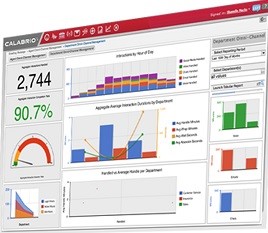Home > Columns
Calabrio Advanced Reporting Product Review
Sheri Greenhaus, Managing Partner of CrmXchange, sat down with Rachel Auer, Product Marketing Manager, Calabrio. They discussed Calabrio’s Advanced Reporting for the modern, multichannel contact center.
Q: Let’s talk about why a powerful and accurate contact center reporting and analytics platform is important to contact centers.
As we know, there is data from all types of technologies coming into the contact center. Getting all of that data in a single spot is challenging. This is where Calabrio’s Advanced Reporting product comes in. It’s taking reporting data a step further, combining Calabrio WFO data with other data sources.
Q: What are the steps that someone needs to take to import the data into the reporting system?
With the comprehensive reporting solution, we pull together disparate contact center data streams—any format and any source, including automatic call distribution (ACD), interactive voice recognition (IVR), quality monitoring, workforce management, CRM, human resources, homegrown software applications, and more. Integrate structured and unstructured data.
If the workforce data is already in the system, we use what we call adapters. These are business intelligence applications for contact center data sources that Calabrio has built. It is a perfect way to pull the data over into Advanced Reporting. With those adapters comes data connections and transformations, a reporting data warehouse called a library and pre-built dashboarding and reporting which lets our customers start to combine all of their data. We also have something called connectors.
Q: What is the difference between a connector and adapter?
An adapter is a full, built-out repeatable process. You connect it, it plugs in, and we are good to go. A connector is a little bit more of a DIY or discovery process. Sort of like, “what data do you want to bring over and how often”.
Q: Can you give me an example of where someone would use an adapter or a connector?
Amazon Connect would be an adapter because it is a pretty robust solution with a lot of data both historical and real-time coming into the system. A connector is for something more generic, like SQL Server or a CSV file and could be for an internal database that they built themselves. We work with you to customize and build the solution, called a Data Library, to your exact needs.
Q: Before companies had a way to compile all this data in one place, what were typical customers doing?
Customers were doing what we call spreadmarts, which is one person on a team that pulls data down into an excel document and combines it.
Q: I assume there are errors with that?
Yes - that's the big thing. As you can imagine - you pull it down from whatever system you have, and as soon as you pull it down on a specific date and time, now it’s inaccurate. It could be that there was a wrong filter that you didn’t realize, you then go through all the work of combining your excel spreadsheets. Maybe the person who sent you the excel spreadsheet says, “I noticed I pulled the data from the wrong year,” requiring you to go back and update your data and filter it again.
Q: With your system, if a customer comes to the conclusion that they made a mistake with data or with a filter, what would that person have to do?
If you built a dashboard or a report and realized, “oh I wanted to pull on the last 3 months but I accidentally pulled on the last 4,” then it's just one click - and it updates automatically. So far, we have been talking about historical data. It should be noted that we can also report on real-time data. Real-time data is not something that you can pull onto excel sheets.
Q: Can you give me an example of where you see this work best?
Most recently, we hear customers talking about our Amazon connect. It is beneficial to look at their near real-time WFM data with their Amazon connect data in one real-time dashboard.
Q: If I was a supervisor, in real-time, I have access to everything occurring with my workforce?
Exactly! Yes - all in one dashboard. And then you can filter by group, by team, by region, by agent… all in one spot.
|
 |
Q: Are there any alerts that can be set up? Like parameters for “normal” and if something falls out of normal it alerts you?
Yes, we can always do a drill down - that's the capability. For customers on the backend, they usually color-code: yellow, green, red. The red is an alert like “you should look at this” but it isn’t a pop up saying, “Alert! Alert!”.
Q: Does a company need to have the Calabrio WFO or WFM solution for reporting to work?
No, they don’t. They can buy Advanced Reporting stand-alone themselves.
Our Data Explorer reporting product is within our WFO solution. This solution uses some features from our Advanced Reporting technology to build reports and dashboards; but it only uses the Calabrio WFO data. This reporting is free with our product.
The next step-up is Advanced Reporting, where you tie in third-party data as well as more real-time third-party data.
Q: With advanced reporting, can a customer bring in data in real-time from any place? For example, can you bring in social media data?
Yes, anything that's pulling data, if it's in real time, it's just about how often you want that data to sync. Some companies require data to be brought in real-time, others need data at the end of the day.
Q: Is the system architected so if there is another technology available a year from now, can I have that data also and pull that information in?
Yes - and that's where that concept that we first talked about with connectors comes in. It's open enough to bring in anything.
Q: Anything that we know about and that we don't know about?
Yes, and that's where I was going with companies having their own homegrown solution. We don’t know what system A, B, and C are going to be but we can get that data out.
Q: Do you have any customer stories that you can share?
Advance reporting pulls together data streams from across the business, connects systems from multiple vendors and creates a central view of all contact center locations. The ability to centralize all data creates a central source of truth for business information.
One of my favorite stories is a company that has a Calabrio suite, which includes all of our products. They were growing so quickly, they were not able to bring on internal agents fast enough. They made the decision to outsource some of their calls multiple third party BPOs.
The company felt like they didn't have a good pulse on the whole WFM story because it was in three different areas and they were having a hard time holistically reporting on what the agent activity was: how long the hold calls were, and everything between their internal ones and separate BPOS. They purchased Advanced Reporting to get a better look at their total workforce management.
Due to Calabrio’s Advanced Reporting, they were able to combine their WFO data for the agent plus the BPO data in advanced reporting. They used our solution not only to coordinate schedules and agent activity, but also to tie in their CRM and telephony systems for billing purposes.
They have been using the reporting for four months now. They are finding that they would rather have the agents in-house than have the BPOs. I think they are having some language barriers.
Q: Going back to the beginning of our conversation, somebody from one department will pull data into a spreadsheet. In some respects, it’s ‘working’. How do you justify an investment in this product?
When we use the term working, we can compare it to an excel spreadsheet ‘working’ as a workforce management scheduling system. It's the same conversation around “how accurate the data is?” Some will say, “oh it seems accurate enough”.
Advanced reporting provides a tremendous amount of saved time. The advantage of this product is that you can give a lot of people access to this dashboard so you don't have to be a data monkey, just sitting on this data and sending it out daily, monthly, etc. You can have the dashboard send it out for you.
There have been a variety of studies done over the years about the costs associated with “spreadmarting” and organizations find time and time again that they can recoup their investment in their business intelligence purchase on their reduction and removal of the costs of creation and maintenance of all of those spreadsheets.
Q: What about something like enhanced decision making? Have you found that there are differences in being able to make a more accurate decision about what to do about a particular issue?
Yes - that is a good point. Another thing I should point out is that a lot of people don't have access to the reporting in these systems, they may not have the real-time IVR data or the Amazon Connect data because of their permissions for accessing that specific tool. In Advanced Reporting they get that real-time insight because they can log in and see it.
We provide a self-service reporting structure that anyone can use—from the frontline of the contact center to the boardroom. There is no need for a data science degree. We use drag-and-drop functionality to create ad hoc reports.
Q: I always think it's valuable to see exactly what's going on in real time.
With Advanced Reporting, companies can employ in-the-moment data insights to hit the ground running, boost employee engagement, and make on-the-fly decisions that immediately improve contact center performance.
As an example, the contact center can pull in marketing data and see that the marketing team sent out a campaign on a specific topic. Through real time reporting, it may be apparent that there is a certain type of “call” or “agents” are on call longer because the messaging was not clear. The contact center team wouldn't usually have access to that marketing data.
Q: Is there anything else that you would like to add?
I think the big advantage of using Advanced Reporting is that our focus is on the contact center data. Once does not start out on a blank slate; we have reports and dashboards ready for you. Sometimes we get, “why wouldn't I just use X or Y system?” And usually the problem is that the contact center doesn't have a seat at the table, they have to say “will you build me this specific report?” And then there's a change two months later that they have to make adjustments but can’t do it themselves. Our solution is built specifically for the contact center. Should the customer need help with building a report or dashboard or have a question, we are experts in contact center data and metrics and in business intelligence.
Q: You are experts in the field of contact centers, while other types of reporting is more general. You can get companies up and running faster. Would you say that's one of your strengths?
Yes. If companies want to build an agent performance dashboard, we can advise of best practices and metrics.
When we work on a project, we have experts in reporting and experts in contact centers working with companies to make sure they have everything they need from a report and dashboard standpoint from the very beginning. We don't just install it and say “good luck!” It's very new for a lot of contact center people.
 |
Rachel Auer, Product Marketing Manager, Calabrio |